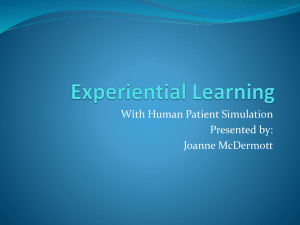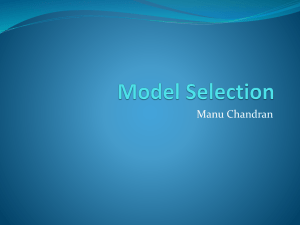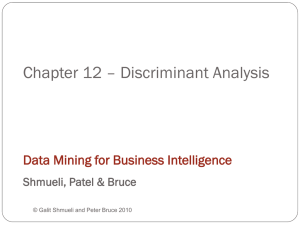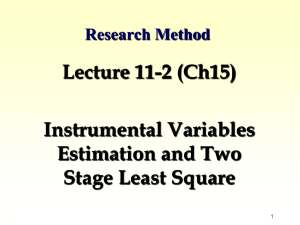Lecture Guide: Graphical Summaries of Distributions
advertisement
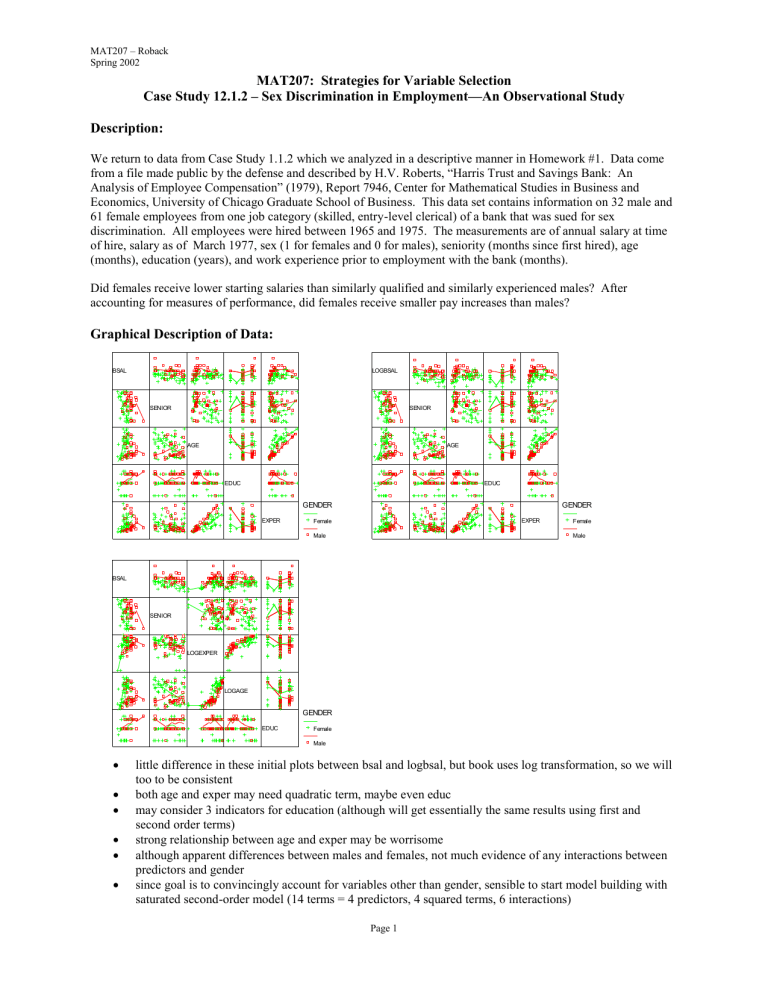
MAT207 – Roback Spring 2002 MAT207: Strategies for Variable Selection Case Study 12.1.2 – Sex Discrimination in Employment—An Observational Study Description: We return to data from Case Study 1.1.2 which we analyzed in a descriptive manner in Homework #1. Data come from a file made public by the defense and described by H.V. Roberts, “Harris Trust and Savings Bank: An Analysis of Employee Compensation” (1979), Report 7946, Center for Mathematical Studies in Business and Economics, University of Chicago Graduate School of Business. This data set contains information on 32 male and 61 female employees from one job category (skilled, entry-level clerical) of a bank that was sued for sex discrimination. All employees were hired between 1965 and 1975. The measurements are of annual salary at time of hire, salary as of March 1977, sex (1 for females and 0 for males), seniority (months since first hired), age (months), education (years), and work experience prior to employment with the bank (months). Did females receive lower starting salaries than similarly qualified and similarly experienced males? After accounting for measures of performance, did females receive smaller pay increases than males? Graphical Description of Data: BSAL LOGBSAL SENIOR SENIOR AGE AGE EDUC EDUC GENDER EXPER GENDER EXPER Female Male Female Male BSAL SENIOR LOGEXPER LOGAGE GENDER EDUC Female Male little difference in these initial plots between bsal and logbsal, but book uses log transformation, so we will too to be consistent both age and exper may need quadratic term, maybe even educ may consider 3 indicators for education (although will get essentially the same results using first and second order terms) strong relationship between age and exper may be worrisome although apparent differences between males and females, not much evidence of any interactions between predictors and gender since goal is to convincingly account for variables other than gender, sensible to start model building with saturated second-order model (14 terms = 4 predictors, 4 squared terms, 6 interactions) Page 1 MAT207 – Roback Spring 2002 Saturated Second-order Model: must Transform…Compute all squared terms and interactions (ugh!) when doing Analyze…Regression…Linear, it helps to move all candidate predictors to end of spreadsheet correlation table from Analyze…Correlate…Bivariate VIFs in Coefficients table from selecting Collinearity Diagnostics under Statistics in Linear Regression .3 .2 .1 Model 1 R .705a R Square .497 Unstandardized Residual Model Summaryb Adjusted R Square .407 Std. Error of the Estimate 9.949E-02 a. Predictors: (Constant), EDUBYEXP, SENIOR2, EDUC, AGE, EXPER2, SENBYEXP, AGEBYEDU, SENBYEDU, EDUC2, SENBYAGE, AGEBYEXP, AGE2, SENIOR, EXPER -.0 -.1 -.2 -.3 8.3 b. Dependent Variable: LOGBSAL 8.4 8.5 8.6 8.7 8.8 8.9 Unstandardized Pr edicted V alue Correlations LOGBSAL SENIOR AGE EDUC EXPER Pearson Correlation Sig. (2-tailed) N Pearson Correlation Sig. (2-tailed) N Pearson Correlation Sig. (2-tailed) N Pearson Correlation Sig. (2-tailed) N Pearson Correlation Sig. (2-tailed) N LOGBSAL 1.000 . 93 -.294** .004 93 .065 .537 93 .407** .000 93 .188 .071 93 SENIOR -.294** .004 93 1.000 . 93 -.184 .077 93 .060 .569 93 -.075 .477 93 AGE .065 .537 93 -.184 .077 93 1.000 . 93 -.225* .030 93 .798** .000 93 EDUC .407** .000 93 .060 .569 93 -.225* .030 93 1.000 . 93 -.101 .335 93 EXPER .188 .071 93 -.075 .477 93 .798** .000 93 -.101 .335 93 1.000 . 93 **. Correlation is significant at the 0.01 level (2-tailed). *. Correlation is significant at the 0.05 level (2-tailed). Coefficientsa Model 1 (Constant) SENIOR AGE EDUC EXPER SENIOR2 AGE2 EDUC2 EXPER2 SENBYAGE SENBYEDU SENBYEXP AGEBYEDU AGEBYEXP EDUBYEXP Unstandardized Coefficients B Std. Error 6.835 1.340 2.678E-02 .022 1.717E-04 .002 7.995E-02 .078 3.376E-03 .003 -1.33E-04 .000 9.425E-07 .000 1.388E-03 .002 -1.59E-06 .000 -3.55E-06 .000 -5.99E-04 .000 1.090E-05 .000 -6.98E-05 .000 -3.72E-06 .000 -7.50E-05 .000 Standardi zed Coefficien ts Beta 2.125 .186 1.412 2.376 -1.718 1.030 .590 -.361 -.320 -1.080 .656 -.998 -1.836 -.651 t 5.102 1.218 .073 1.023 1.048 -1.128 .542 .741 -.481 -.242 -1.219 .442 -1.087 -.880 -.876 Sig. .000 .227 .942 .310 .298 .263 .589 .461 .632 .809 .227 .660 .281 .382 .384 95% Confidence Interval for B Lower Bound Upper Bound 4.168 9.502 -.017 .071 -.005 .005 -.076 .236 -.003 .010 .000 .000 .000 .000 -.002 .005 .000 .000 .000 .000 -.002 .000 .000 .000 .000 .000 .000 .000 .000 .000 Collinearity Statistics Tolerance VIF .002 .001 .003 .001 .003 .002 .010 .011 .004 .008 .003 .008 .001 .012 472.164 1012.083 295.800 798.235 359.564 559.476 98.346 87.244 271.041 121.765 342.055 130.870 675.285 85.736 a. Dependent Variable: LOGBSAL residual plot looks fine, but high VIFs and lack of significance of any predictors indicates there’s problems with multicollinearity Identifying Good Subset Models: Analyze…Regression…Linear. Dependent = logbsal; independent(s) = all 14 candidates; Method = stepwise or backward or forward (can set criteria under Options) Page 2 MAT207 – Roback Spring 2002 a) Stepwise Variables Entered/Removeda Model 1 Variables Entered Variables Removed EDUC2 . SENBYED U . SENBYEX P . AGEBYEX P . EXPER . Model Summary Model 1 2 3 4 5 6 7 R .422a .535b .574c .616d .645e .645f .680g R Square .178 .287 .329 .379 .415 .415 .462 Adjusted R Square .169 .271 .306 .351 .382 .389 .431 Std. Error of the Estimate .1178 .1103 .1076 .1041 .1016 .1010 9.747E-02 2 3 4 a. Predictors: (Constant), EDUC2 b. Predictors: (Constant), EDUC2, SENBYEDU 5 c. Predictors: (Constant), EDUC2, SENBYEDU, SENBYEXP d. Predictors: (Constant), EDUC2, SENBYEDU, SENBYEXP, AGEBYEXP e. Predictors: (Constant), EDUC2, SENBYEDU, SENBYEXP, AGEBYEXP, EXPER 6 . 7 EDUBYEX P f. Predictors: (Constant), EDUC2, SENBYEDU, AGEBYEXP, EXPER g. Predictors: (Constant), EDUC2, SENBYEDU, AGEBYEXP, EXPER, EDUBYEXP SENBYEX P . Method Stepwise (Criteria: Probability-of-F-to-enter <= .050, Probability-of-F-to-remove >= .100). Stepwise (Criteria: Probability-of-F-to-enter <= .050, Probability-of-F-to-remove >= .100). Stepwise (Criteria: Probability-of-F-to-enter <= .050, Probability-of-F-to-remove >= .100). Stepwise (Criteria: Probability-of-F-to-enter <= .050, Probability-of-F-to-remove >= .100). Stepwise (Criteria: Probability-of-F-to-enter <= .050, Probability-of-F-to-remove >= .100). Stepwise (Criteria: Probability-of-F-to-enter <= .050, Probability-of-F-to-remove >= .100). Stepwise (Criteria: Probability-of-F-to-enter <= .050, Probability-of-F-to-remove >= .100). a. Dependent Variable: LOGBSAL b) Backward c) Forward Model Summary Model 1 2 3 4 5 6 7 8 9 R .705a .705b .705c .704d .704e .702f .698g .695h .692i R Square .497 .497 .497 .496 .495 .492 .487 .484 .479 Adjusted R Square .407 .415 .421 .427 .433 .437 .438 .441 .442 Std. Error of the Estimate 9.949E-02 9.886E-02 9.828E-02 9.778E-02 9.726E-02 9.692E-02 9.684E-02 9.659E-02 9.648E-02 a. Predictors: (Constant), EDUBYEXP, SENIOR2, EDUC, AGE, EXPER2, SENBYEXP, AGEBYEDU, SENBYEDU, EDUC2, SENBYAGE, AGEBYEXP, AGE2, SENIOR, EXPER b. Predictors: (Constant), EDUBYEXP, SENIOR2, EDUC, EXPER2, SENBYEXP, AGEBYEDU, SENBYEDU, EDUC2, SENBYAGE, AGEBYEXP, AGE2, SENIOR, EXPER c. Predictors: (Constant), EDUBYEXP, SENIOR2, EDUC, EXPER2, SENBYEXP, AGEBYEDU, SENBYEDU, EDUC2, AGEBYEXP, AGE2, SENIOR, EXPER d. Predictors: (Constant), EDUBYEXP, SENIOR2, EDUC, EXPER2, AGEBYEDU, SENBYEDU, EDUC2, AGEBYEXP, AGE2, SENIOR, EXPER e. Predictors: (Constant), EDUBYEXP, SENIOR2, EDUC, AGEBYEDU, SENBYEDU, EDUC2, AGEBYEXP, AGE2, SENIOR, EXPER f. Predictors: (Constant), EDUBYEXP, SENIOR2, EDUC, AGEBYEDU, SENBYEDU, AGEBYEXP, AGE2, SENIOR, EXPER g. Predictors: (Constant), EDUBYEXP, EDUC, AGEBYEDU, SENBYEDU, AGEBYEXP, AGE2, SENIOR, EXPER h. Predictors: (Constant), EDUBYEXP, EDUC, AGEBYEDU, SENBYEDU, AGEBYEXP, AGE2, EXPER i. Predictors: (Constant), EDUC, AGEBYEDU, SENBYEDU, AGEBYEXP, AGE2, EXPER Model Summary Model 1 2 3 4 5 6 R R Square .422a .178 b .535 .287 .574c .329 d .616 .379 .645e .415 f .680 .463 Adjusted R Square .169 .271 .306 .351 .382 .425 Std. Error of the Estimate .1178 .1103 .1076 .1041 .1016 9.795E-02 a. Predictors: (Constant), EDUC2 b. Predictors: (Constant), EDUC2, SENBYEDU c. Predictors: (Constant), EDUC2, SENBYEDU, SENBYEXP d. Predictors: (Constant), EDUC2, SENBYEDU, SENBYEXP, AGEBYEXP e. Predictors: (Constant), EDUC2, SENBYEDU, SENBYEXP, AGEBYEXP, EXPER f. Predictors: (Constant), EDUC2, SENBYEDU, SENBYEXP, AGEBYEXP, EXPER, EDUBYEXP Page 3 MAT207 – Roback Spring 2002 a-c) Create a model based on sequential variable selection techniques (honoring rule to include linear terms whenever those terms are used in quadratic or interaction terms): Model Summary Model 1 R .681a Adjusted R Square .413 R Square .464 Std. Error of the Estimate 9.903E-02 a. Predictors: (Constant), EDUBYEXP, SENIOR, EDUC, AGE, AGEBYEXP, EXPER, EDUC2, SENBYEDU Coefficientsa Model 1 (Constant) SENIOR AGE EDUC EXPER EDUC2 SENBYEDU AGEBYEXP EDUBYEXP Unstandardized Coefficients B Std. Error 8.148 .561 1.899E-03 .006 4.928E-05 .000 2.678E-02 .056 4.506E-03 .001 1.845E-03 .002 -4.21E-04 .000 -3.75E-06 .000 -1.40E-04 .000 Standardi zed Coefficien ts Beta .151 .053 .473 3.172 .784 -.760 -1.849 -1.217 t 14.512 .344 .348 .476 4.781 1.082 -.972 -3.604 -2.669 Sig. .000 .731 .729 .636 .000 .282 .334 .001 .009 95% Confidence Interval for B Lower Bound Upper Bound 7.031 9.264 -.009 .013 .000 .000 -.085 .139 .003 .006 -.002 .005 -.001 .000 .000 .000 .000 .000 Collinearity Statistics Tolerance VIF .033 .271 .006 .015 .012 .010 .024 .031 30.011 3.696 154.977 68.952 82.240 95.698 41.232 32.548 a. Dependent Variable: LOGBSAL Collinearity Diagnosticsa Model 1 Dimension 1 2 3 4 5 6 7 8 9 Eigenvalue 7.774 1.052 .117 2.908E-02 1.335E-02 1.034E-02 4.032E-03 4.770E-04 9.607E-05 Condition Index 1.000 2.719 8.138 16.350 24.134 27.415 43.910 127.656 284.463 (Constant) .00 .00 .00 .00 .00 .01 .01 .00 .98 SENIOR .00 .00 .00 .01 .00 .00 .00 .26 .74 AGE .00 .00 .04 .31 .07 .37 .15 .00 .07 EDUC .00 .00 .00 .00 .00 .00 .00 .10 .90 Variance Proportions EXPER EDUC2 .00 .00 .00 .00 .00 .00 .00 .00 .00 .01 .10 .00 .83 .00 .01 .74 .06 .24 SENBYEDU .00 .00 .00 .00 .00 .01 .01 .25 .73 AGEBYEXP .00 .00 .00 .00 .40 .03 .56 .00 .00 EDUBYEXP .00 .00 .02 .00 .43 .01 .36 .00 .17 a. Dependent Variable: LOGBSAL some guidelines suggest VIF>10 or Condition Index>30 imply possible problems with multicollinearity d) Book’s Model (Section 12.6): Analyze…Regression…Linear. Dependent = logbsal; independent(s) = first enter all 4 main effects and hit Next to identify Block 1, then enter remaining 10 predictors as Block 2; Method = stepwise .3 .2 Model Summ ary R R Square .568a .322 .635b .403 .685c .469 Adjust ed R Square .292 .369 .431 Unstandardized Residual Model 1 2 3 St d. Error of the Es timate .1088 .1026 9.743E-02 .1 -.0 -.1 a. Predic tors: (Constant), EXPER, SENIOR, EDUC, AGE b. Predic tors: (Constant), EXPER, SENIOR, EDUC, AGE, AGEBYEXP c. Predic tors: (Constant), EXPER, SENIOR, EDUC, AGE, AGEBYEXP, AGEBYEDU -.2 -.3 8.3 8.4 8.5 Unstandardized Pr edicted V alue Page 4 8.6 8.7 8.8 MAT207 – Roback Spring 2002 Coefficientsa Model 1 2 3 (Constant) SENIOR AGE EDUC EXPER (Constant) SENIOR AGE EDUC EXPER AGEBYEXP (Constant) SENIOR AGE EDUC EXPER AGEBYEXP AGEBYEDU Unstandardized Coefficients B Std. Error 8.658 .139 -4.12E-03 .001 -1.66E-04 .000 2.388E-02 .005 4.972E-04 .000 8.567 .134 -3.70E-03 .001 1.352E-05 .000 2.004E-02 .005 2.813E-03 .001 -3.69E-06 .000 7.887 .245 -3.15E-03 .001 1.241E-03 .000 7.203E-02 .017 2.856E-03 .001 -3.72E-06 .000 -1.02E-04 .000 Standardi zed Coefficien ts Beta t 62.338 -3.631 -1.173 4.641 2.365 64.057 -3.435 .095 4.022 4.007 -3.439 32.214 -3.041 3.090 4.315 4.284 -3.655 -3.247 -.327 -.180 .422 .350 -.293 .015 .354 1.980 -1.818 -.250 1.347 1.272 2.010 -1.834 -1.464 Sig. .000 .000 .244 .000 .020 .000 .001 .925 .000 .000 .001 .000 .003 .003 .000 .000 .000 .002 95% Confidence Interval for B Lower Bound Upper Bound 8.382 8.934 -.006 -.002 .000 .000 .014 .034 .000 .001 8.301 8.832 -.006 -.002 .000 .000 .010 .030 .001 .004 .000 .000 7.400 8.373 -.005 -.001 .000 .002 .039 .105 .002 .004 .000 .000 .000 .000 Collinearity Statistics Tolerance VIF .951 .328 .932 .352 1.051 3.045 1.073 2.844 .939 .285 .885 .028 .025 1.065 3.511 1.130 35.610 40.755 .914 .033 .071 .028 .025 .030 1.094 30.735 14.073 35.624 40.759 32.902 a. Dependent Variable: LOGBSAL Collinearity Diagnosticsa Model 1 2 3 Dimension 1 2 3 4 5 1 2 3 4 5 6 1 2 3 4 5 6 7 Eigenvalue 4.556 .386 3.387E-02 2.014E-02 4.600E-03 5.226 .708 3.388E-02 2.043E-02 6.720E-03 4.279E-03 6.193 .713 4.508E-02 3.383E-02 8.379E-03 5.925E-03 5.995E-04 Condition Index 1.000 3.437 11.597 15.040 31.471 1.000 2.716 12.419 15.995 27.887 34.947 1.000 2.947 11.721 13.530 27.186 32.330 101.639 (Constant) .00 .00 .00 .01 .99 .00 .00 .00 .01 .06 .93 .00 .00 .00 .00 .05 .02 .92 SENIOR .00 .00 .00 .36 .64 .00 .00 .00 .36 .04 .60 .00 .00 .09 .00 .60 .21 .10 Variance Proportions AGE EDUC EXPER .00 .00 .01 .00 .01 .30 .42 .32 .40 .22 .44 .14 .36 .24 .16 .00 .00 .00 .00 .01 .00 .37 .30 .03 .20 .38 .00 .00 .21 .86 .43 .10 .10 .00 .00 .00 .00 .00 .00 .00 .00 .00 .04 .02 .03 .01 .01 .21 .00 .03 .75 .94 .94 .00 AGEBYEXP AGEBYEDU .00 .01 .00 .01 .80 .19 .00 .01 .00 .00 .16 .83 .00 .00 .00 .03 .00 .03 .01 .92 a. Dependent Variable: LOGBSAL note that even this model is not immune from multicollinearity issues. However, removing any of these predictors significantly affects performance, plus we’re not planning prediction and we don’t seem to have extremely high standard errors of coefficients Details of Stepwise procedure: Variables Entered/Removedb Model 1 2 3 Variabl es Entered EXPER, SENIOR, a EDUC, AGE AGEBYEXP AGEBYEDU Variabl es Removed Method . Enter . . Stepwi se (Criteria: Probability-of-F-to-enter <= .050, Probability-of-F-to-remove >= .100). Stepwi se (Criteria: Probability-of-F-to-enter <= .050, Probability-of-F-to-remove >= .100). a. All requested variables entered. b. Dependent Vari able: LOGBSAL Page 5 MAT207 – Roback Spring 2002 Excluded Variablesd Model 1 SENIOR2 AGE2 EDUC2 EXPER2 SENBYAGE SENBYEDU SENBYEXP AGEBYEDU AGEBYEXP EDUBYEXP SENIOR2 AGE2 EDUC2 EXPER2 SENBYAGE SENBYEDU SENBYEXP AGEBYEDU EDUBYEXP SENIOR2 AGE2 EDUC2 EXPER2 SENBYAGE SENBYEDU SENBYEXP EDUBYEXP 2 3 Beta In -1.101a -1.494a 1.178a -.938a .221a -.310a -.072a -1.448a -1.818a -1.061a -.868b 2.428b 1.078b -.279b .083b -.092b -.109b -1.464b -1.169b -1.023c 1.138c .413c -.187c .158c -1.149c .086c -.319c t -.711 -1.908 1.515 -3.175 .301 -.378 -.093 -3.005 -3.439 -2.303 -.592 1.744 1.466 -.485 .119 -.118 -.149 -3.247 -2.713 -.737 .803 .557 -.341 .239 -1.457 .124 -.498 Sig. .479 .060 .133 .002 .764 .707 .926 .003 .001 .024 .555 .085 .146 .629 .905 .906 .882 .002 .008 .463 .424 .579 .734 .811 .149 .902 .620 Collinearity Stati stics Minimum VIF Tolerance 309.695 3.229E-03 82.072 1.218E-02 79.752 1.242E-02 12.501 5.519E-02 69.314 1.443E-02 86.961 1.150E-02 76.609 1.229E-02 32.899 3.040E-02 40.755 2.454E-02 28.920 3.393E-02 310.381 3.222E-03 289.243 3.457E-03 79.881 1.242E-02 47.725 6.427E-03 69.552 1.438E-02 87.557 1.142E-02 76.625 8.645E-03 32.902 2.453E-02 29.050 1.504E-02 310.748 3.218E-03 323.359 2.791E-03 88.299 7.993E-03 47.857 6.411E-03 69.639 1.109E-02 101.874 9.380E-03 77.208 8.612E-03 65.785 9.676E-03 Partial Correlation -.076 -.200 .160 -.322 .032 -.040 -.010 -.307 -.346 -.240 -.064 .185 .156 -.052 .013 -.013 -.016 -.330 -.281 -.080 .087 .060 -.037 .026 -.156 .013 -.054 Tolerance 3.229E-03 1.218E-02 1.254E-02 7.999E-02 1.443E-02 1.150E-02 1.305E-02 3.040E-02 2.454E-02 3.458E-02 3.222E-03 3.457E-03 1.252E-02 2.095E-02 1.438E-02 1.142E-02 1.305E-02 3.039E-02 3.442E-02 3.218E-03 3.093E-03 1.133E-02 2.090E-02 1.436E-02 9.816E-03 1.295E-02 1.520E-02 a. Predictors i n the Model: (Cons tant), EXPER, SENIOR, EDUC, AGE b. Predictors i n the Model: (Cons tant), EXPER, SENIOR, EDUC, AGE, AGEBYEXP c. Predictors i n the Model: (Cons tant), EXPER, SENIOR, EDUC, AGE, AGEBYEXP, AGEBYEDU d. Dependent Variable: LOGBSAL Book's model: Resid plot vs. Age .3 .3 .2 .2 .1 Unstandardized Residual .1 -.0 -.1 -.2 -.3 200 300 400 500 -.0 -.1 -.2 -.3 600 700 800 -.2 A GE 0.0 .2 .4 .6 .8 1.0 1.2 GENDER can plot residuals against variables in the model (left) to see if a different form of that variable is needed (turns out Age squared does not help), or against variables not in the model (right) to see if those variables should be added Final Model (add Gender into best subset model): b Model Summ ary Model 1 R .773a R Square .598 Adjust ed R Square .564 St d. E rror of the Es timate 8.528E -02 a. Predic tors: (Constant), GE NDE R, E XPE R, SENIOR, EDUC, AGE, A GE BYE DU, AGEBY EXP b. Dependent Variable: LOGB SAL Coeffi cientsa Model 1 Unstandardized Coeffic ients B St d. E rror (Const ant) 8.278 .227 SE NIOR -3. 48E -03 .001 AGE 9.147E -04 .000 EDUC 4.235E -02 .016 EXPER 2.181E -03 .001 AGEB YEDU -5. 46E -05 .000 AGEB YEXP -3. 23E -06 .000 GE NDER -.120 .023 St andardi zed Coeffic ien ts Beta -.276 .993 .748 1.535 -.780 -1. 594 -.442 t 36.460 -3. 830 2.562 2.700 3.650 -1. 876 -3. 608 -5. 219 Sig. .000 .000 .012 .008 .000 .064 .001 .000 95% Confidenc e Int erval for B Lower Bound Upper Bound 7.827 8.729 -.005 -.002 .000 .002 .011 .074 .001 .003 .000 .000 .000 .000 -.165 -.074 a. Dependent Variable: LOGB SAL although some high leverages, no real problems with influential points Page 6 Collinearity Statisti cs Tolerance VIF .910 .032 .062 .027 .027 .024 .660 1.099 31.707 16.205 37.372 36.529 41.207 1.515


